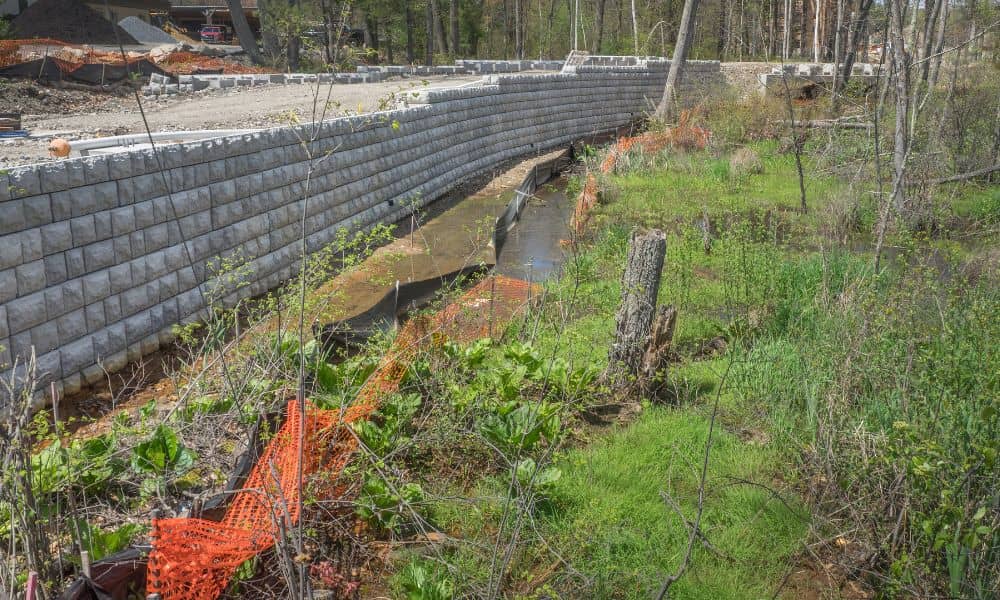
Retaining walls are an important part of many properties. They hold back soil, prevent erosion, and keep yards safe, especially in hilly areas. But recent flooding problems are shining a spotlight on how these walls are built. In fact, this flooding crisis could change how retaining walls are designed and constructed starting in 2025. If you’re a homeowner, builder, or contractor, it’s important to understand what’s happening and why it matters.
What’s Going On in Huntsville?
In the last few months, heavy rainstorms hit Huntsville harder than usual. The city even faced what experts call a “100-year storm”—meaning a very rare and intense rain event. This caused flooding in many neighborhoods, leading to damage and worry for residents.
One big story came from the Summit at Monte Sano development. The city issued a stop work order on this construction project because people complained that the work was making flooding and erosion worse nearby. The main concern? How the site was being prepared and how stormwater was being handled.
This is a big deal for anyone involved in construction, especially masonry contractors who build retaining walls. That’s because these walls play a key role in managing soil and water on a property.
Why Retaining Walls Matter in Flood Control
Retaining walls do more than just look nice or add value to a home. They keep soil from washing away during heavy rain. When built properly, they direct water safely down slopes and prevent dangerous erosion.
However, if retaining walls aren’t designed or installed correctly, they can fail under pressure from water and soil. This failure can cause cracks, leaning walls, or even collapse, making flooding problems worse instead of better.
Huntsville’s flooding crisis has shown that some construction projects might not be paying enough attention to how water moves across the land. This has pushed city officials to rethink their rules and inspections around retaining walls and other drainage solutions.
How This Could Change Building Rules
The stop work order at Summit at Monte Sano wasn’t just about one project. It signals a bigger shift in how Huntsville will handle construction going forward. City leaders are likely to introduce stricter building codes and permit requirements related to stormwater management and erosion control.
For retaining walls, this means:
- Tougher inspections: Contractors may face more detailed checks to make sure walls can handle heavy rain and soil pressure.
- Better design standards: Builders might need to include extra drainage features, use stronger materials, or follow new engineering guidelines.
- Increased paperwork: Permitting processes could require more documentation showing how water runoff will be managed safely.
These changes aim to protect neighborhoods from flooding and preserve the quality of construction work.
What Masonry Contractors Need to Do
If you’re a masonry contractor, these changes mean adapting your work to meet new demands. Early communication with city permit offices will be key to avoiding costly delays.
Contractors should also focus on:
- Improved drainage solutions: Installing gravel backfill, weep holes, and perforated pipes behind retaining walls can help water escape, reducing pressure.
- Stronger foundations: Walls built on solid, well-prepared bases resist shifting and cracking during floods.
- Material selection: Using quality bricks, stones, and mortar that stand up to moisture and freeze-thaw cycles will make walls last longer.
Also, keeping good records and proof of compliance can speed up approvals and keep projects moving.
What Homeowners Should Know
For homeowners, these changes might mean a few things. You could see longer project timelines or slightly higher costs as builders spend more time on design and compliance. But these investments will pay off with safer, more durable retaining walls that protect your property.
When hiring a contractor, ask if they’re familiar with the new stormwater regulations and whether they’ve worked on projects with updated codes. A knowledgeable contractor will ensure your retaining wall meets local standards and withstands wet weather.
Also, keep an eye on your retaining walls after storms. If you notice cracks, bulges, or leaning, don’t wait. Early repairs can prevent bigger problems and protect your home.
Looking Ahead: Building Resilience
Huntsville’s flooding crisis is a clear reminder that weather patterns can change quickly, and construction has to keep up. Retaining walls will still be key to managing water and soil, but as building rules evolve, homeowners and builders will need to adjust too.
Improving how these walls are designed and inspected will help reduce flooding risks and protect neighborhoods. At the same time, many homeowners are thinking about how to make their outdoor spaces more enjoyable and durable. That’s where quality masonry and outdoor living solutions come in—things like patios, fire pits, or outdoor kitchens built to handle Huntsville’s weather and last for years.
This way, properties don’t just stay safe—they become places where families can relax and enjoy the outdoors, rain or shine.
Conclusion
Retaining walls are more than just landscape features—they’re critical defenses against erosion and flooding. The recent flooding crisis and the stop work order at Summit at Monte Sano have highlighted the need for better construction practices and stricter oversight.
Starting in 2025, expect changes to building codes and inspection standards for retaining walls. Contractors will need to update their methods, and homeowners should look for experts familiar with these new requirements.
If you’re planning a retaining wall project or need repairs, work with professionals who understand unique climate and evolving rules. This way, your retaining wall will not only look great but stand strong for years to come.